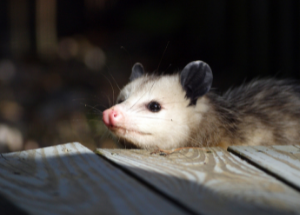
- VisitSupport Happy HollowDONATE TODAYExploreSupport Happy HollowDONATE TODAYLearnSupport Happy HollowDONATE TODAYSupport
-
Today's Hours: 10:00 am to 4:00 pm
Education AmbassadorsVirginia Opossum

Scientific Name: Didelphis virginiana
Family: Didelphidae
Order: Didelphimorphia
Class: Mammalia
Range: North America
Habitat: Grasslands, forests, wetlands, and urban areas
Lifespan: 1-2 years in the wild; 2-4 yeas in captivityWhat do they look like?
Virginia opossums are the only species of marsupial found in North America. They have a triangular head with a pointed snout and long whiskers. Opossums have white faces, while the rest of their body is covered in long grey or black guard hairs dispersed though a creamy or
white undercoat. The ears, feet, and tail are bare. They have a prehensile tail which allows them to grasp branches as they climb through trees, though they don’t hang from their tails. Their front paws have five clawed toes, while the back feet have four clawed toes and an opposable, clawless hallux, the innermost toe of the foot. The Virginia opossum has 50 teeth –
more than any other North American land mammal! The only other mammals with more teeth are giant armadillos and toothed whales.How do they behave?
Opossums are timid, solitary, and nocturnal. They have poor vision, but an excellent sense of smell, which they use to locate food. Opossums are infamous for their reaction to threats. When startled, it is common for them to react by “playing ‘possum.” This is an involuntary reaction in which they roll over, stiffen, drool, and take slow, shallow breaths. This state can last hours and often fools predators into thinking the opossum has suddenly died.What’s on the menu?
Opossums are omnivores. They have a flexible diet and eat a variety of carrion, insects, plants, and fruits. Urban-dwelling opossums often see pet food and discarded garbage as an easy meal. At the Zoo, they eat mice, insects, fish, eggs, fruit, and vegetables.How are they born?
Virginia opossums can breed throughout most of the year. Less than two weeks after mating, upwards of 20 bean-sized infants may be born, though litters of 8-9 are most common. However, females only have 13 teats; if more than 13 young are born, only those who attach to a teat will have a chance to survive. They will remain in the mother’s pouch for approximately 3 months. By 4-5 months of age, they will be fully weaned and on their own. Opossums have an unusually short life span considering their size and metabolic rate.Is it an opossum or a possum?
“Opossum” is the proper name given to the Virginia opossum found in North America. The word opossum was first used by John Smith in the early 1600’s. It is derived from the Algonquian word “wapathemwa” or “apasum” meaning “white animal.” Possums are arboreal marsupials native to Australia and are named after Virginia opossums.Conservation Connection
Virginia opossums are classified as a species of Least Concern by the International Union for Conservation of Nature (IUCN). However, opossums get a bad rap for having a “frightening” appearance and startling displays when in fact they are very helpful to people as they can eat up to 5,000 ticks in a season, preventing the spread of Lyme Disease! To discourage opossums from living too close for comfort, avoid leaving doors and windows open at night, secure garbage containers and keep pet food inside. Pick up fruit that falls from trees and keep yards free of brush piles that may provide shelter for wild animals.
Zoo on the Hill
Located across from the Keep-Around Carousel is the Zoo on the Hill. Learn about wildlife up close during daily meet-and-greets, leap like a lemur on the playground, brush and feed the goats,, or take a peek inside Doc’s Critter Care building and the Ranch House. Double-H Ranch features a combination of animal exhibits, including giant anteaters and red ruffed lemurs, as well chickens and domesticated animals that are docile enough to touch.
See Animals
Zoo in the Hollow
Follow the crooked bamboo pathway down into the hollow and visit with some of the most amazing animals in the world. Where else in San José can you get up close to a stunning jaguar, lemur, meerkat or American alligator? Happy Hollow is dedicated to helping save species and preserve wildlife for future generations by participating in Species Survival Plan programs through the Association of Zoos and Aquariums.
See AnimalsVisit Us Today
Plan an unforgettable experience at San Jose’s family-friendly park and zoo.
more info